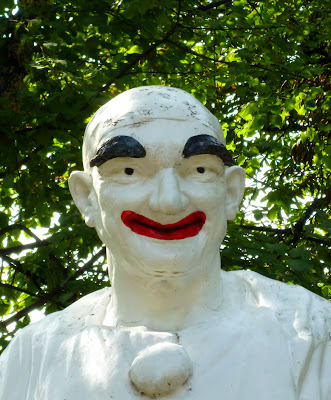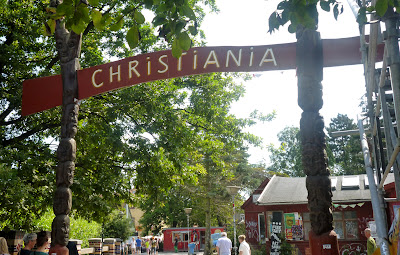On Tuesday I went with my daughter to see the Damien Hirst show at Tate Modern. I didn't really want to see it, to be honest, but D is doing an Arts Award, one part of which is to write up something you've been to see. Damien's pills and sharks and butterflies seemed likely to provoke responses.
As we were walking towards the ticket desk to get our tickets, down in the lower level, I suddenly sensed, without really seeing it, a kind of collective movement. There was no extra noise, but a definite sense of intention. People were striding down the slope towards the Turbine Hall. Quite a lot of people. I felt excited -- 'Is it a flash mob?' I hissed at D. I was very much hoping that all these marching people were going to break into song. Even an impromptu performance of 'Thriller' would have thrilled me.
Still watching to see what might happen, we went to stand in the ticket line. Just then a woman of about my own age came up to me and launched into an account of how her grandmother had given her a purple suede mini-skirt forty years ago and how it had empowered her. She stood right in front of me and stared into my eyes. It was very disconcerting to be addressed at random in this way and held captive by the narrative. I felt an incredible sense of obligation, that, as always, I should be polite and listen. But at the same time it wasn't a normal interaction. I didn't know what it was but I tried to signal to D to catch it on film. I think I mouthed 'Film it!' at her, but was too polite to speak over the woman. By now she was saying that she had recently given the purple mini-skirt to her own daughter or granddaughter (not sure which -- it was hard to take it all in as I was too busy trying to process what sort of incident I was now part of). D didn't film it!
The woman came to the end of her story and wheeled away, joining the marchers again. By now they had been up and down the length of the building a few times and were running round in circles, following a leader, I think. Who the leader was was hard to work out.
We watched for a few minutes longer. By now I had decided that it must be some sort of happening laid on by the Tate, although I had no idea what. You could see other visitors were being stopped by people from the group and spoken to intently. I wondered what stories they were being told and whether they were more interesting than 'my' story, which I hadn't really liked. The experience of being buttonholed and given a story, whether I liked it or not, was very strange and I guess that's the intention. It isn't an entirely 'fair' interaction because the person on the receiving end doesn't know the 'rules' of the game, and they don't seem to be encouraged to participate, to ask questions, to tell a story in turn. In a way, you are 'assaulted' by the story -- but at the same time you feel special, privileged to have been singled out, for whatever reason, to be the receiver of this unique moment.
Later on, at home, I discovered that it had been the first day of the latest Turbine Hall 'installation'. The group of people (or similar groups) will be marching and running and telling stories to people every day until October 28th. I had a particularly intense experience of this 'artwork', which is titled 'These associations' and devised by Anglo-German artist Tino Sehgal, because I knew nothing about it beforehand and had to find a way to respond to it whilst immersed in it. It was quite provocative, but not really as 'dangerous' as the Director of Tate Modern has proclaimed it: "the most complex, difficult and dangerous project we have ever put into this museum". One is taken by surprise, discomfited, possibly entertained, but not threatened or even asked to do anything other than look and, possibly, listen. I felt I would have liked to be part of the group, marching down the slope and back again, running round. I started to think about what stories I would have told people. Maybe that's enough.
Reviews have started to appear: Guardian, Telegraph.
Holiday report parts 2 and 3 will follow soon.
Thursday, 30 August 2012
Sunday, 26 August 2012
Before my holidays are gone for ever -- Part 1
Woaah, it feels strange stepping back onto my blog after a fairly long hiatus. Sorry for the silence. I can't really blame the fact that I've been on holiday, as that was only two weeks out of quite a few more than that. But it's the desire to do a holiday post that has actually delayed my return because it's just so daunting.
I have over 500 holiday photos, most of them really poor, and they have to be waded through and weeded out. And I want to write about the holiday in some detail so that I have a good record of it, but it all takes sooo much time. Still... here we go.
The above two photos are my visual clues as to where we've been: a chance version of the flag of the first country we went to (seen on the side of a boat) and blue and yellow flowers for the other country (in a planter there). Have you guessed yet? Not too difficult really: Denmark and Sweden.
We flew to Copenhagen, the brevity of the flight bringing home just how close Skandinavia is to us in the UK. Copenhagen was founded in the late twelfth century by the dashing chap above, Absalon, who combined being a bishop with being a warrior in a way that seems entirely unfeasible today.
We felt very relaxed as soon as we arrived in Copenhagen. It was very laidback and we hadn't done any of our usual slightly obsessive planning of what we wanted to do. We just set out from our hotel and wandered. We soon found ourselves at Nyhavn, the old canalside street full of cafes which is really the heart of the 'tourist' centre but it didn't feel tacky, just friendly and welcoming. We went down into the sunken ground floor of what seemed to be a really old pub/restaurant for something to eat and, feeling the Skandi-love, I decided to have the herring buffet. Ten or twelve different 'ways with herring'! And just some new potatoes, bread and radishes to leaven the herringness.
I did enjoy my gigantic plate of fish but now that I've had it once I don't think I'll ever need to have it again. Under all the various sauces, it was very much still herring.
 |
| My 'slot' to photograph the Little Mermaid before the chafing Japanese tourists asked me to move out of the way |
Closely followed by the Royal Hotel, designed in the Sixties by Arne Jacobsen. Now a Radisson Blu hotel, you can visit Room 606, which is the only room still furnished with Jacobsen's specially designed furniture:
On a whim we jumped onto a canal boat cruise and thus got to see some fantastic new buildings (the new National Theatre, the new Opera House, the new National Library, a super-trendy floating hotel which I would like to stay in one day) and some beautiful older ones too, particularly the canalside area of Christianshavn.We also saw an MA art show at the Nikolaj Tower, a decommissioned church which made a brilliantly gothic art gallery:
There was art to be found all over the city, even underwater. This spooky merman and his seven merchildren gaze up from beneath the surface of the canal, imploring their human wife and mother to come back to them:
And I also liked this sculptural maze (easy to cheat, though):
We loved Norrebro, the district to the north-west of the city centre, which has streets of great vintage shops, and also the boho University district. We also went to the Danish Design Centre and saw a good exhibition about new materials.
Of course, it wouldn't be a proper trip to Copenhagen without a visit to the Tivoli Gardens, which I had been repeatedly urged to go to by my Dad, who thinks they are heaven on earth. They were very nice (but my idea of heaven on earth is to follow, in part two of this blog) and the buildings reminded me a little of the Festival of Britain back in 1951 (a very good thing):
It felt very safe and our kids were able to go off to the rides while we had a nice lunch.
 |
| My kids coming down to earth (at the top of the picture) |
 |
| Tivoli clown statue |
Christiania is a self-declared 'free state' within Copenhagen, mostly famous for openly selling drugs. We were just curious to see it but only stayed for about ten minutes as it felt a bit paranoid and sinister. There were a great many signs everywhere forbidding photography, and I don't suppose the drugs on sale are any freer from dodginess and misery up the supply-chain than anywhere else. It's pretty amazing (to us from the uptight UK) that such an enclave is tolerated, but perhaps the city think it somehow practical to corral the hippies and dopedealers there -- not all of them, obviously, but a fair number -- and practise a kind of vigilant tolerance. I think there are signs that the authorities may try to close it down at some time in the not too distant future. A great set of photos from inside Christiania by Maja Daniels here.
This first leg of our holiday was over (apart from a last, farewell bounce on the trampolines set into the pavement just by our hotel) and so we got a taxi to take us to the train station. But when the driver found out we were going to take the train across the Oresund Bridge to Sweden, he offered to drive us right to the door of our hotel in Malmo. We had so much luggage that, after thinking briefly about how much it was going to cost, we sagged back in the upholstery and said, 'Yes please'. So it was in grand style that we crossed the beautiful and famous bridge, humming the theme tune to The Killing as we went.
Tune in next time for Malmo and Lund in Part Two... (Here's a little taster)
Subscribe to:
Posts (Atom)


















